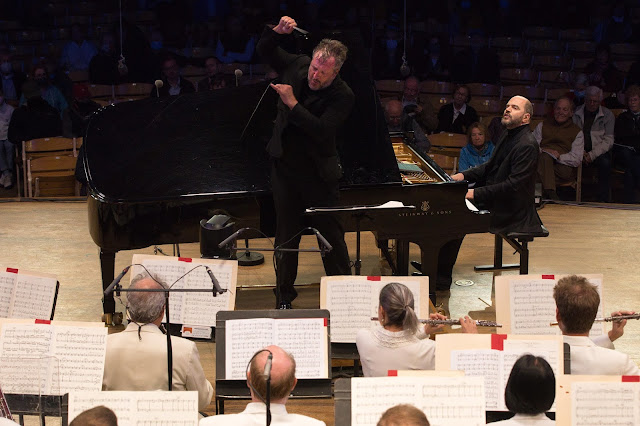Adès-Gerstein dream team take on Stravinsky concerto at Tanglewood
Kirill
Gerstein and Thomas Adès continue to share a fruitful musical partnership. The
pianist-conductor duo drew international acclaim two seasons ago, when Gerstein
premiered Adès's Piano Concerto with the Boston Symphony Orchestra. With Adès
conducting, the performance of the blazing and haunting score seemed to capture
in music a friendship connected by a similar artistic vision.
That
was the sense conveyed Saturday night, when Adès and Gerstein tackled
Stravinsky's Concerto for Piano and Winds with the BSO at Tanglewood's
Koussevitzky Shed. The performance once again showcased Gerstein's technical
prowess and searching expressivity. And Adès, who proved a technicolor conductor,
led the way.
Stravinsky's thorny score dates from 1924 while the composer was exploring classical and
baroque forms. His previous works—the Symphonies of Wind Instruments and
Octet—sought to combine old styles with bristly modern sonorities.
Adès
and Gerstein rendered the concerto in bold colors. Biting brass sonorities
brought immediate tension to the opening passages, which erupted in a flurry of
activity under Gerstein's fingers. Full of crash-and-bang intensity, the
pianist's phrases, which hint at ragtime rhythm, sounded with crystalline
precision. The wind musicians of the BSO, under Adès's clear direction,
answered in kind.
By
removing most of the strings from the ensemble, Stravinsky created an
emotionless, anti-Romantic sound world. Yet there was nothing overtly objective
about Gerstein's rendering of the second movement. There, the pianist found a
tender expression that perfectly suited Stravinsky's Schumannesque piano
writing.
Gerstein
also explored the movement's chamber-like intimacy. Brief solos from English
hornist Robert Sheena and oboist John Ferrillo provided supple complement to
the pianist's lines. The cadenza offered colorful effects, with Gerstein's
phrases taking on a hazy resonance in the upper register.
The
finale moved intently, with trumpeter Thomas Rolfs deftly handling the wide
acrobatic leaps that accompanied Gerstein's percussive statements. Raucous
flourishes from all players brought the concerto to a rousing conclusion.
The
rest of the program found Adès exploring the lyrical qualities of two Haydn
symphonies and his own O Albion for string orchestra.
The
latter work originated as the sixth movement from Adès's 1994 string quartet, Arcadiana. Scored for string orchestra in 2019, O Albion is the gem
of that setting: at once an idyllic nod to Elgarian pastoralism and spiritual
serenity.
The
music is deceptively simple, unfolding slowly from a falling phrase that takes
on plush resonance and biting dissonance as it progresses over a three-minute
span. Adès drew playing of radiant warmth from the BSO strings, the opening lines
seeming to grow from a whisper, yet never rising above it.
The
Haydn symphonies that bookended the program showed just as much sensitivity for
the musical line.
Adès
has a fine feel for Haydn's music, and he drew attention to every dynamic shade
and curve of the phrase in the composer's Symphony No.
64 in A.
Though
cast in a major key, this work, nicknamed Tempora mutantur, bears some storm-and-stress
intensity. Brief shifts to minor keys, handled with assurance by Ades and the
orchestra, bring momentary tension to an otherwise sunlit score.
The
Menuetto took on a sure-footed lilt, with clarion calls from the horns making for
a resonant trio. The finale coursed with fleet and surging energy.
But
the heart of this performance was the Largo, which Adès shaped in vocal arcs.
Even the many stretches of silence that Haydn used to interrupt the melodic
flow carried the intensity forward. This was a Haydn in which to revel as the
conductor elicited a sensuous blend from the strings. A solo oboe phrase
brought a touch of darkness; beaming horn phrases tilted the music briefly towards
the light.
The
concert's closer, Haydn's Symphony No. 45 in F-sharp minor, displayed equal
amounts of sensitivity and drama.
The
opening movement was a true essay in tension and resolution. The Menuet lilted, with horns again sounding harmonious in the trio.
Here
too, Adès shaped the second movement as if it were an aria, the lines rising,
hovering on shimmering harmonies, and falling away.
The
final Adagio offered a light-hearted ending to the concert. Haydn had written this
symphony to convince his employer, Prince Nikolaus Esterházy, who tended to
stay at his palace long into the summer months, to let the musicians in his
orchestra take a much-deserved break.
Adès
and BSO acted out the work's historic ending, with musicians leaving the stage
in pairs and groups when their parts were completed. As Adès led, the ensemble
gradually shrunk from orchestra to sextet, quartet, and eventually violin duet.
When the last two violinists left the stage, Adès, ever the showman, kept
conducting in silence. He then shrugged, turned to the audience, and took his
bow to warm applause.

.jpg)


Comments
Post a Comment